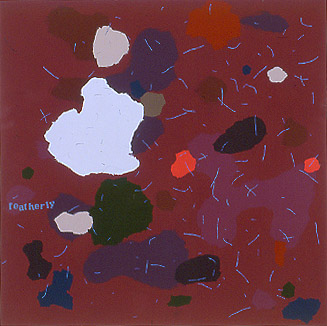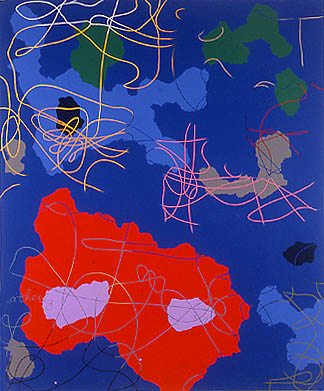Jack Featherly's "As If" Paintings
by Tom MoodyJack Featherly's new paintings are sophisticated, dumb abstractions on large wood panels. "Dumb" because they're amorphous, solid-color blobs made with 1 Shot R sign-painter's enamel, blocked in with spectacularly crude, brushy edges (none of that intricate, Mark Rothko over-and-under stuff here--what Featherly brushes is pretty much what you see). "Sophisticated" because the blobs cover an underlayer, also abstract, that is selectively revealed through sharply delineated windows, created with masking-tape stencils. (Cut strips of tape are applied to the dry underlayer, then painted over, then the tape is pulled up.) The outlines of these windows have a focus and precision the blobs mostly lack, although the subject matter--amoeboid ovals, looping, mock-calligraphic scribbles, molecular chains of dung-ball atoms, and the artist's ever-present signature (rendered big, in various typebook fonts)--is ultimately just as dopey.

First Night Back in London, 2001, enamel on panel, 48" X 48"By combining the quest for pure form characteristic of mid-20th-Century abstraction with a cheeky graphic sensibility reminiscent of downtempo electronica packaging, Featherly manages to be sincere without being starry-eyed or smarmy. The paintings have all the pleasure of a spontaneous first draft without indulging in AbEx pretensions about the meaning of same; they take the viewer into an alternate universe of hazy spectral forms without being in denial about the work's status as a "cultural product," to use the artist's term. An old-school purist like Clyfford Still might be appalled by the disjunction of tones, but as Featherly reminds us, one generation's idea of sincerity is not the same as another's. To admit a painting's connections to a stream of commerce, to lifestyle, to the surrounding visual world of advertising and design, is generally a more honest declaration of intentions today than claiming it is somehow apart from such things.
Nevertheless, the tension between playing with cultural signifiers and purging them has been a constant throughout Featherly's career. Viewers could not help but note the drastic streamlining that occurred between his debut exhibition in 1995, which overflowed with quotations from art and media history, and his second show, three years later, which seemed shockingly empty. Gone were the manga characters, imitation Lite-Brite designs, purloined children's book illustrations, aggressive font stylings, even the liquid plastic coating that gave the early paintings their glossy, new-car feel; all that remained were bands of smoothly-applied, (comparatively) dry oil paint, prompting critics to discuss the work in terms of color-field painting. The canvases didn't completely relinquish their roots in appropriation, however: each was based on a NASCAR racing stripe pattern for that year, hiding in plain sight with some of the stripes selectively fuzzed out.
Since the '98 show, Featherly's work has made a couple of swings on the content pendulum: from the eccentric austerity of the 1999 "ray" paintings, which jettisoned appropriation completely in favor of skewed spatial exploration, to found imagery again, such as the cartoon wizard in F2K (1999) and the cameo patterns in Sugarbowl (2000), to the current paintings, which started out highly reductive, but are gradually filling up as this essay is being written. Images haven't reappeared, but the linear, stencilled elements are growing more complicated, challenging the dominance of the blocky, cloud-like forms. There is more of a tease between nature and culture, between the Zen-like methodology of "feeling your way along the edge of the positive and negative space" (as Featherly describes Clyfford Still's process) and the knowing manipulation one finds in loungecore graphics.

Barbiturate, 2002, enamel on panel, 72" X 60"In discussing the new work, Featherly emphasizes that he isn't appropriating or spoofing Still, Rothko, et al; rather, he's studying and internalizing their methods, knowing full well that when he applies them, the result isn't AbEx, but a kind of atomized blend of his influences, ranging up and down the cultural spectrum. One of the amusing ironies of the new paintings is that for all Featherly's attempts to purify them, by working flat on the floor, letting the forms grow and collide organically, even using random processes akin to the string-throwing of Duchamp's "standard stoppages" to create the linear elements, the result still looks stylish and mediated. When the gap between art and life--between Franz Kline and a Lord & Taylor bag--has shrunk to molecular size, the paintings seem to ask, who needs to appropriate?
To some extent Featherly's career arc (creating works of image-jammed, world-encompassing complexity, then getting back to "basics," which are in turn revealed to be just as susceptible to cultural influences) knowingly mirrors a struggle played out less consciously in society at large. In religion, circuit-riding preachers rail against the liturgy, trappings, and scholarship of the High Church, claiming that all the knowledge they need resides in the "good book," then create non-profit foundations to carry on their legacies. In government, would-be reformers dream of replacing the Internal Revenue Code's web of rules and exceptions with a "flat tax," which would of course require interpretation. In music one sees a similar transition: from Wagner to Cage to Steve Reich, from prog to punk to new wave. Featherly's new paintings--starting out simple, getting more complex--operate "as if" purity was possible.
Tom Moody is an artist based in New York. His interview with Jack Featherly can be found at http://www.digitalmediatree.com/tommoody/featherly/interview